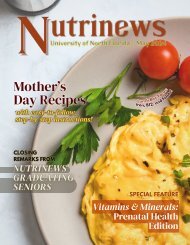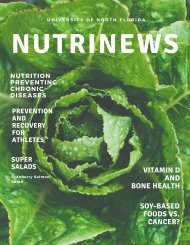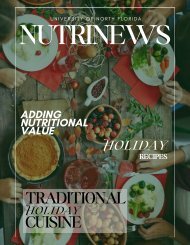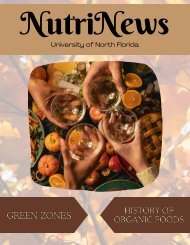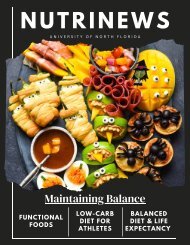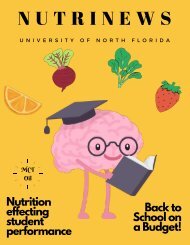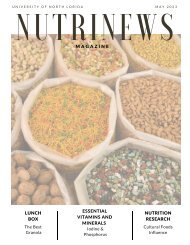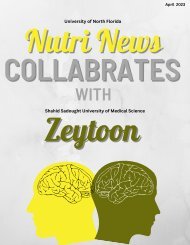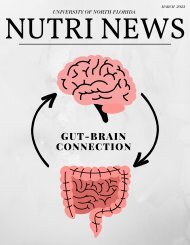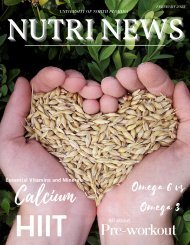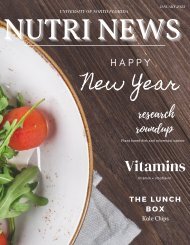February Issue 2024
This month the theme of our issue is Young at Heart. February is here and that means heart health month is too! In this issue of NutriNews we focus on nutrition and heart health. Lifestyle and nutrition play a significant role in our health, especially when it comes to the heart.
This month the theme of our issue is Young at Heart. February is here and that means heart health month is too! In this issue of NutriNews we focus on nutrition and heart health. Lifestyle and nutrition play a significant role in our health, especially when it comes to the heart.
Create successful ePaper yourself
Turn your PDF publications into a flip-book with our unique Google optimized e-Paper software.
In contrast, SFAs and trans fats should be<br />
limited since these fats do not have the<br />
same benefits for athletes. Excessive<br />
amounts of SFAs and trans fat contribute to<br />
a high risk of cardiovascular disease and<br />
obesity. 2 In addition, these fats can<br />
increase inflammation causing an athlete's<br />
muscles to get sore making it difficult to<br />
recover from exercising. 6 Furthermore,<br />
specific trans fatty acids influence the<br />
regulation of lipid metabolism,<br />
inflammation, and oxidative stress which<br />
can negatively impact an athlete’s<br />
performance. 7 For instance, vigorous or<br />
prolonged exercise can increase the<br />
production of reactive oxygen species<br />
(ROS) in cells that promote redox<br />
disturbances; thus, resulting in oxidative<br />
damage on a cellular level. 8<br />
This type of cellular consequence can be<br />
demonstrated at rest and during exercise<br />
because ROS are continually produced in<br />
both segments. Therefore, if the oxidative<br />
damage is not properly addressed it could<br />
eventually lead to an athlete having a<br />
muscle injury. 8 Overall, dietary fat is<br />
essential for growth, provides satiety, and is<br />
a source of long-term energy. 6 The<br />
amount of fat an athlete consumes<br />
depends on their energy needs and sports’<br />
intensity. However, in terms of fuel for<br />
exercise, trans fat and SFAs should be<br />
limited during training and competitions<br />
due to the increased risk of inflammation<br />
and injury. 6 On the other hand, MUFAs and<br />
PUFAs display a range of benefits that<br />
athletes can obtain by consuming sources<br />
rich in n-3, n-6, and n-9 fatty acids such as<br />
fish, nuts, avocados, and oils. 1,4 As such,<br />
these fats should remain a natural part of an<br />
athlete’s diet to improve performance.<br />
References<br />
1.Field CJ, Robinson L. Dietary Fats. Adv Nutr. 2019;10(4):722-724. doi:10.1093/advances/nmz052<br />
2. DiNicolantonio JJ, O'Keefe JH. Monounsaturated Fat vs Saturated Fat: Effects on Cardio-Metabolic Health and Obesity. Mo Med.<br />
2022;119(1):69-73.<br />
3. NSWIS Nutrition Team. An athlete’s Guide to Understanding Dietary Fat. NSW Institute of Sport (NSWIS). <strong>February</strong> 18, 2020.<br />
https://www.nswis.com.au/nutrition/an-athletes-guide-to-understanding-dietary-fat/.<br />
4. Kawamura A, Nemoto K, Sugita M. Effect of 8-week intake of the n-3 fatty acid-rich perilla oil on the gut function and as a fuel<br />
source for female athletes: a randomised trial. British journal of nutrition. 2023;129(6):981-991. doi:10.1017/S0007114522001805<br />
5. Thielecke F, Blannin A. Omega-3 Fatty Acids for Sport Performance-Are They Equally Beneficial for Athletes and Amateurs? A<br />
Narrative Review. Nutrients. 2020;12(12). doi:10.3390/nu12123712<br />
6. Flack KD, Hays HM, Moreland JE. Dietary fat and athletic performance. FCS3-622 University of Kentucky. <strong>February</strong> 2019.<br />
http://www2.ca.uky.edu/agc/pubs/FCS3/FCS3622/FCS3622.pdf.<br />
7.Oteng AB, Kersten S. Mechanisms of Action of trans Fatty Acids. Adv Nutr. 2020;11(3):697-708. doi:10.1093/advances/nmz125<br />
8. Powers SK, Deminice R, Ozdemir M, Yoshihara T, Bomkamp MP, Hyatt H. Exercise-induced oxidative stress: Friend or foe? Journal<br />
of sport and health science. 2020;9(5):415-425. doi:10.1016/j.jshs.2020.04.001<br />
27




